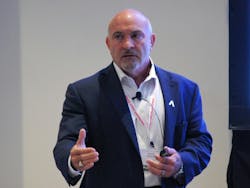If simulations are good for designs, why stop there?
This logical question appears to be fueling the emergence of digital twins from their origin in design spaces to help with construction, installation, configuration, operations, maintenance, and even long-term and end-of-life processes.
“Understanding more about the complex physics involved in any function can enable it from birth to its entire lifecycle,” said Scott Parent, Field CTO at design and simulation software leader Ansys. “Honeywell and Ansys are present in every industry from aerospace and defense to medical and healthcare, but they both deal with the same physical forces that must be addressed from design to safety, and in every segment, including drones, pacemakers and energy-storage systems for buffering wind and solar applications, plus all the variables their users must deal with to optimize them.”
Parent spoke on the occasion of “Gigafactory Day” at the 2024 Honeywell Users Group today in Madrid. His keynote presentation was timed with the official launch of Honeywell’s Battery Manufacturing Excellence Platform (Battery MXP), an artificial intelligence (AI)-powered software solution that, like today’s digital twin technology, is designed to optimize the operation of gigafactories from day one by improving battery cell yields and expediting facility startups for manufacturers.
Digital twins meet digital engineering
Just as simulations and digital twins let users try numerous design scenarios before building physical application and systems, they can also be used to derisk technologies that users are contemplating, and point out how to increase efficiencies, reduce their carbon impact, and scale up the most useful alternatives. Parent reported that users embracing simulations and digital twins are called hyperscalers because they’re using high-performance computing, AI, machine learning (ML), cloud-computing, and Internet of Things (IoT) platforms to perform digital engineering tasks far more quickly than was possible before.
“One side of the spectrum is adopting and running with digital twins and digital engineering, and they can do in one day what takes their competition 30 days,” explained Parent. “Hyperscalers in the digital ecosystem ae coming together to accelerate all forms of digital insight and intelligence, and drive productivity, knowledge growth and sharing, and disruptive learning across science.”
For instance, Ansys recently worked with a pump manufacturer re-engineering its subsystems at the component level, such as impeller spare parts. With help from an Ansys simulation, the manufacturer found it could improve overall performance by 80%.
“Companies like this are going to be uncatchable,” added Parent. “Digital engineering improves ultimate product performance and enhances all aspects of its lifecycle. The battery industry has reported a 65% improvement in material usage by using generative simulations to improve additive manufacturing. They still do physical tests, but digital engineering can help integrate batteries into automotive body frames, which reduces weight and improves performance. Digital twin can deliver higher ROI throughout the entire battery lifecycle.”
Scaling up to the gigafactory
Once they prove useful and successful for batteries and other products, simulation and digital engineering principles can be applied to entire units, plants and businesses. They also enable multidisciplinary design analysis and optimization, as well as model-based systems engineering, which reduces expenses all along the lifecycle pathway, including R&D, production and deployment, operations and support, and disposal and recycling.
For example, Ansys also worked with Northrup for Aerospace’s battery engineering division that takes a long-term, lifecycle-management view. It used a digital twin and virtual sensors to develop reduced-order models (ROM) for the manufacturer’s electrode production process, which could be used to develop controls and manage asset performance. They described each step in the electrode production process, such as coating, drying and calendaring, and built process digital twins for each one. This helped optimize the physical and cyber/computerized subsystems, and reduced their material usage and cost sensitivity.
“This is like using the ‘triangle of speed’ to optimize a road trip. The value of ROI in assets becomes more alive in the digital twin world,” said Parent. “To achieve similar gains, users must start by asking questions such as: What will the application’s digital footprint be? What information will be needed to serve it? And what will data have to look like to better manage the process and plant?”
About the Author

Leaders relevant to this article:

